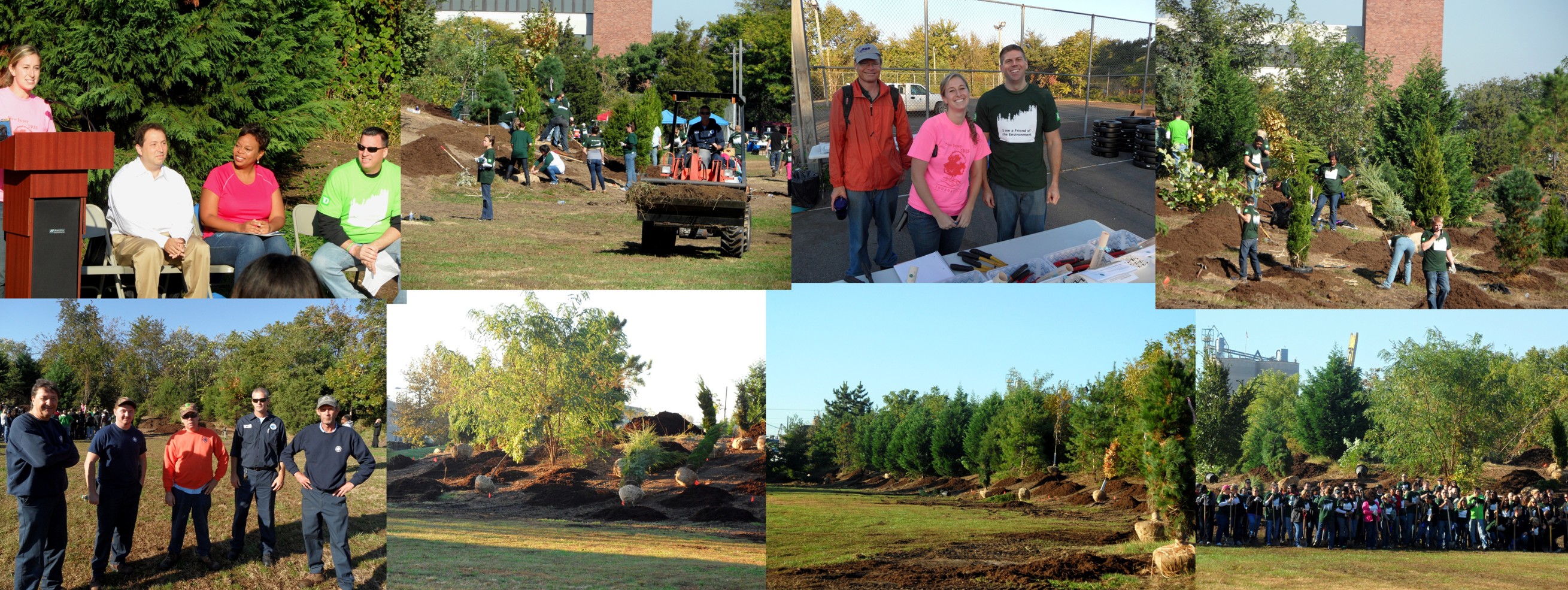Liney Ditch Park and the Camden County Municipal Utilities Authority (CCMUA) are located in the Waterfront South in Camden City. This neighborhood experiences the worst air quality in Camden, with many industrial neighbors contributing pollution and unpleasant odors. For years, the community has requested more trees in Liney Ditch Park and in the neighborhood as a whole. The NJ Tree Foundation (NJTF) is a member of Alliance for Community Trees and the tree planting is made possible by partnership with TD Bank. NJTF is a state-wide non-profit organization dedicated to planting trees in New Jersey’s most under-served neighborhoods.
On October 15, 2013, the NJTF, with assistance of Camden City, CCMUA and TD Bank, undertook the largest tree planting in Camden City. Over 90 TD bank volunteers planted the trees as part of TD Tree Day. The deciduous and evergreen trees planted absorb odors and stormwater, improve air quality, provide shade, beautify Liney Ditch Park, and provide wildlife habitat. The 117 new trees planted are now part of the shelterbelt surrounding the CCMUA Waste Water Treatment Plant.
The community partners for this tree planting include the NJ Tree Foundation, the Heart of Camden (HOC), Center for Environmental Transformation (CFET), Camden Stormwater Management and Resource Training (SMART), Camden Special Services District (CSSD) and the City of Camden. The HOC and the CFET are neighborhood-based nonprofits that use the park often and have requested trees from the NJ Tree Foundation. Camden SMART planted the Ferry Avenue rain garden and had requested trees for that location. CSSD is responsible for watering the new trees.
Shelterbelts are vegetation systems that use trees arranged in row or group configurations to redirect wind and reduce wind speeds, thereby modifying environmental conditions within the upwind and downwind sheltered zones. Trees are highly effective at physically intercepting dusts, gases and microbial particles that are carried in the wind. Shelterbelts have the ability to reduce odor concentrations significantly by several different means. On windy days a shelterbelt will create turbulence forcing the odorous air to mix with clean air at higher elevations. Shelterbelts also encourage settling of dust and particulates by reducing wind speeds. These particulates often carry odors. Another mechanism for odor control is the physical interception of dust and particulates. As the odorous air moves through the shelterbelt the odorous particles collect on leaf surfaces thus reducing the odor. The last potential means by which shelterbelts control odor is through absorption of the odorous material on the foliage and the subsequent breakdown of this material via microbial activity.
Trees and shrubs clean the air of micro-particles of all sizes by interception. Interception of air pollutants may be 20 times higher in treed or forested areas than non-forested cropped or barren lands. Conifers show a better ability to absorb air pollutants than deciduous trees. Air pollution research has found that odorous gases and particles can be absorbed into the foliage of conifers and deciduous trees during the growing season. Pollutants diffuse inside leaves and needles through tiny openings called stomata or absorb into waxy coatings that naturally cover leaf surfaces. Odorous gases, chemicals and dust particles can become fixed to plant surfaces and can enter into the plant tissue in three ways: 1) gaseous diffusion through open stomata, 2) on wet leaves, soluble air pollutants can enter through stomata in a dissolved liquid form, 3) pollutants can absorb directly into plant tissues. Micro-organisms cover plant surfaces and they contribute to absorbing odorous materials. Forests are often referred to as air pollution filters, this applies to the shelterbelt.
The CCMUA Waste Water Treatment Plant represents the heart of the Regional Sewer Treatment System in Camden County. This wastewater treatment plant receives nearly all of the sewage generated within Camden County and cleans it to the standards of the Federal Clean Water Act. The plant processes more than 58 million gallons of sewage every day. As the state’s fourth largest treatment facility with a residential neighborhood within 100 yards, odor-control is a major priority and therefore a zero tolerance odor control policy and community outreach is in effect. Over the last decade state of the art odor control upgrades were added to the treatment process. The shelterbelt trees represent an efficient green tool which also reduces the odors from the wastewater treatment plant.
Camden City has a combined sewer system where stormwater and sewage are mixed together. As a result, when sewer system capacity is exceeded during heavy rain the sewage can back up flooding the streets of Camden, the parks and residents’ homes. The shelterbelt helps to mitigate the flooding by absorbing stormwater. Each tree captures approximately 2,000 gallons of stormwater per year. The new trees in Liney Ditch Park now divert an additional 234,000 gallons of stormwater each year from the sewer system.
Dozens rolled up their sleeves on a wet summer morning in Camden
Notes:
“Windbreak/Shelterbelt–Odor Control Conservation Practice Information Sheet” (IS-MO380) 12/04, The United States Department of Agriculture (USDA).
“Mitigating swine odor with strategically designed shelterbelt systems: a review,” John Tyndall and Joe Colletti, Agroforest Syst (2007) 69:45-65, DOI 10.1007/s10457-006-9017-6; Published online: 22 September 2006.

